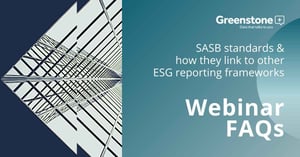SASB standards & how they link to other ESG reporting frameworks -FAQs
 Greenstone’s webinar on the 'SASB standards & how they link to other ESG reporting frameworks' was held last month. The 30-minute session, with a guest speaker from SASB, was very well-attended and we had great feedback from attendees.
Greenstone’s webinar on the 'SASB standards & how they link to other ESG reporting frameworks' was held last month. The 30-minute session, with a guest speaker from SASB, was very well-attended and we had great feedback from attendees.
We had some interesting questions both during and after the webinar. In this blog, we have answered some of the most frequently asked questions on the topic:
In what way is SASB related to the Stakeholder Capitalism Metrics announced by the World Economic Forum?
The WEF/IBC metrics are the result of a one-time process to ‘curate’ metrics from existing standards and frameworks, primarily from GRI. They are industry-agnostic, whereas SASB Standards are industry-specific, and they are designed for alignment with the UN’s Sustainable Development Goals, whereas SASB topics and metrics are selected based on evidence of impact on financial performance. The WEF/IBC metrics could be seen as complementary to SASB reporting but they are not a replacement.
How many companies use the SASB Standards?
556 companies reported using the SASB Standards in 2020, up from 117 in 2019, with 41% of reporters domiciled outside of the US.
How do we get early entrepreneurs in developing countries to key into the success of these collaborations?
Reporting using the SASB Standards has been described as “an easy on-ramp” to ESG reporting because of their laser focus on enterprise value creation and the information needs of investors, resulting in an average of six topics and 13 metrics in each of the 77 industry standards. This makes SASB especially relevant to SMEs and emerging markets companies in addition to large-caps in developed markets. SASB gives companies and investors around the world the ability to communicate on ESG performance based on consistent, comparable and reliable data.
Following the merger with the IIRC and the collaboration with other framework organizations, is it expected that SASB Standards will be updated?
The International <IR> Framework and SASB Standards will remain complementary tools. SASB Standards will continue to be set according to the principles, processes, and practices outlined in the SASB Conceptual Framework and Rules of Procedure. The SASB Standards Board—an independent board that is accountable for the due process, outcomes, and ratification of the SASB Standards—will continue to play the same role.
TCFD provides a number of possible metrics for measuring climate risk and opportunity. Is SASB considering adding those to their standards?
SASB Standards are already well aligned with the TCFD recommendations, for example calling for discussion of governance, strategy and risk management around all ESG topics. While the TCFD recommendations call for the disclosure of scope 1, 2 and 3 GHG emissions, SASB Standards call for scope 1 GHG emissions disclosure in only the 25 industries in which they are likely to be financially material. SASB does not explicitly call for scope 2 and 3 emissions disclosure but instead provides metrics for topics such as energy efficiency or use of renewable energy sources, for example, and supply chain management or environmentally responsible product design, in industries where those topics are linked to financial materiality. Although some aspect of climate risk impacts 68 of the 77 industries covered by the SASB Standards, the metrics are varied and industry-specific, in contrast to the industry-agnostic GHG metrics required by TCFD.
Visit our Frameworks & Standards content library aiming to keep you informed with the latest industry updates and learn more about the available sustainability and ESG frameworks and standards to support your company's reporting.
For more information on how Greenstone’s software can enable companies to meet multiple global sustainability reporting requirements, click here.
To access the recording of the webinar, please visit Greenstone's webinar channel.









